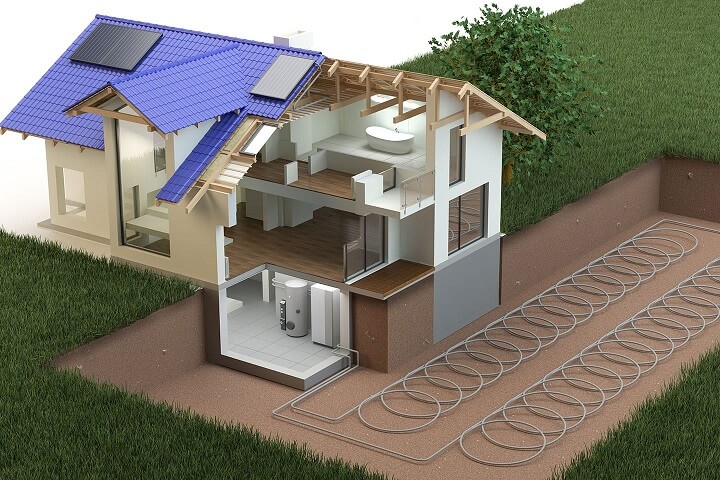In our previous article, we examined the principle of operation of heat pumps in more detail. We will now deal with the most important types of heat pumps. Because different types of heat pumps have different product characteristics, they are able to respond flexibly to a wide range of different building engineering needs.
Typically, different heat pump systems build on the same principle. These are devices that, by their operation, are able to change the traditional direction of heat dissipation, extract heat energy from a lower temperature environment, and transfer it to a higher temperature environment. The most obvious difference among the different systems is the source from which the heat energy is extracted and the medium through which they are able to release this energy. The source of energy is typically the heat of the soil or air, possibly some source of water. The heat energy absorbed by the system is transferred by the heat exchanger either directly to the air in the heated building or to the water in the central heating. According to this, we can distinguish between air-to-air, air-to-water, water-to-water and geothermal systems.
Air-to-air systems
Air-to-air systems are easy to install, they are a good solution in already completed buildings, as the devices can be installed with less renovation and less demolition. If the building consists of several separate building parts, several indoor units are required for the thermal control of these parts. However, this is also an advantage, because in this way the different parts of the building can be regulated separately. Another advantage of the devices is that they can typically be used to heat, cool, dehumidify and filter the air with the same machine.
The system can be integrated into solar solutions, so that the electricity needed to operate the heat pump can be easily covered from renewable energy. Disadvantages of the system include that the outdoor and indoor units produce noise during both heating and cooling, which can disturb those who are sensitive to it. When using air-to-air heat pumps, it must be taken into account that the production of domestic hot water is not solved and cannot be placed directly in a humid medium. Although a reduction in the outside temperature can reduce the efficiency of individual air-to-air heat pumps, units equipped with state-of-the-art EVI compressor technology are now a major step forward in this regard.
Air-to-water systems
Air-to-water heat pumps, like air-to-air systems, use outside air as a heat source. The essential difference between the two technologies is that in air-to-water systems, the heat transfer takes place through a heat exchanger to the water in the central heating. Its advantage is that it not only provides heating, but also usually solves the issue of cooling and domestic hot water production. The system is easy to install with little disassembly.
It can be connected to existing conventional heat-dissipating surfaces during renovation, although it should be noted here that low-temperature heat-dissipating surfaces such as underfloor heating, wall heating, and ceiling heating provide the best operation. Due to the external air heat source, the noise load of the device also arises here, and it is also true for this system that the performance is affected by the change in the outdoor temperature. As the advent of EVI technology has been a major step forward in dealing with temperature-dependent power change, it is considered to be the fastest-growing technology in addition to air-to-air heat pumps due to its lower investment requirements.
Geothermal systems
Geothermal systems can be divided into two major groups. Among solutions that work with water abstraction and into systems that can be operated without water abstraction.
Although both technologies typically have high COP values, in general it can be said that better efficiency can be achieved in theory with water abstraction. Nevertheless, the approval of a heat pump with water abstraction, the potential depletion of the water source, and the damaging effect of any sediment are risk factors that are against water-to-water heat pumps.
In heat pump systems without water abstraction, a pipe snake is placed either horizontally 1.5-3 m above the ground surface or the “U” shaped pipe loop is guided vertically downwards. The former design is also called a ground collector heat pump and the latter a ground probe heat pump. While the soil collector design requires a larger garden area, which cannot be planted with deep-rooted vegetation later, with the soil probing solution this space requirement is much smaller. Installation of both devices is earthy.
In the case of earthworks, the effect of drilling on hard, rocky soil on the price must also be taken into account.

In the case of heat pumps without water abstraction, the heat source is the soil from which the heat is produced with the fluidized pipe system. The recovered heat is then transferred to the heating water circuit by a heat exchanger. Although the investment cost is higher than for the installation of air sourced heat pumps, in return the equipment can be used to solve the cooling, heating and domestic hot water production of the building.
Due to the constant temperature of the soil, we obtain a weather-independent heating system with stable efficiency, characterized by a high COP value, a great temperature and useful life.
When choosing a heat pump, it must be taken into account that different types of tools are optimal for different needs and conditions. For this reason, it is worthwhile to formulate our expectations regarding the thermoregulation system in several respects, and to seek the opinion of an experienced mechanical engineer or energy specialist before choosing.

